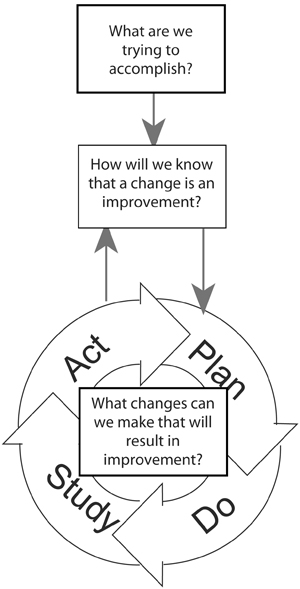Three revolutionary questions: A model for everyday performance improvement
22 April 2014 by Infinite Ideas in Lifestyle
by Jan Gillett, author of Making your work work
It’s easy to come up with complicated ways to change an organisation, but sometimes the simplest of models can be the most powerful. This Three Question Model for everyday performance improvement was developed over twenty years ago by Tom Nolan, Lloyd Provost and colleagues, and has stood the test of time in countless circumstances.
 1. The first vital question is ‘What are we trying to accomplish?’
1. The first vital question is ‘What are we trying to accomplish?’
‘Remind me, what are we trying to do?’ This question often seems to emerge half way through a meeting, when the discussion has wandered from the agenda. People then discover that others have several, maybe conflicting, aims in mind, and are hence talking at cross purposes. When the goal is agreed it’s often clear that the right people aren’t there.
We find this confusion extending all the way from a local meeting to an organisation’s whole strategy. When we ask several people in any office or factory what the aim is we are likely to get many different answers. Ask the members of the board and some will say; ‘to maximise profits’ others will say; ‘to satisfy customers’. And these two do not exhaust the possibilities.
So, a vital discipline for leaders is to clarify the goal: large and long term or small and immediate. How can you hope for cooperative improvement efforts if there isn’t consensus on what you are trying to achieve? This is of course not a new idea, but it’s still rare, and hence it can be revolutionary.
That’s good then, we’ve agreed the goal, can we just get on with actions now please?
2. Well, no, as the second vital question is: ‘How will we know if a change is improvement?’
This may also seem obvious but it’s rarely thought through. Without a good answer you can’t know if you are making progress. We find some managers concentrating on cost, others on service levels, still others on innovation, all thinking their measure is the one that counts. Especially if it’s related to a target or bonus. Many measures are too late, only emerging after the product is finished or the customer has experienced the service – just think of all those surveys after the flight / holiday / service call. Many are not accurate or representative. Few represent the live state of the process. If you are going to lead improvement you need to understand how your work is working, as it is working. Just as a chef tastes the dishes during the cooking, you have to develop meaningful in-process measures, as well as results criteria, that relate to your goal.
3. What changes shall we make that will result in improvement?
Only now can the third question be addressed sensibly. The first two questions thus form a wonderful introduction to making your work work better through the Deming Cycle —Plan-Do-Study-Act. This is the model that brings the scientific method to life for managers and leaders, and that lies behind the continuing revolution in cost, quality and innovation across much of the world’s automotive and aerospace industries.
The Three Question Model is useful for any leader in any role, and in my book, Making your work work I explain how to use it at every stage from understanding one’s customers to making improvements in how the work flows, how to respond to problems and how to prevent them from occurring in the first place. It is a cycle, and leaders must make it revolve, as rapidly as possible, and although it is old, it is still revolutionary.

